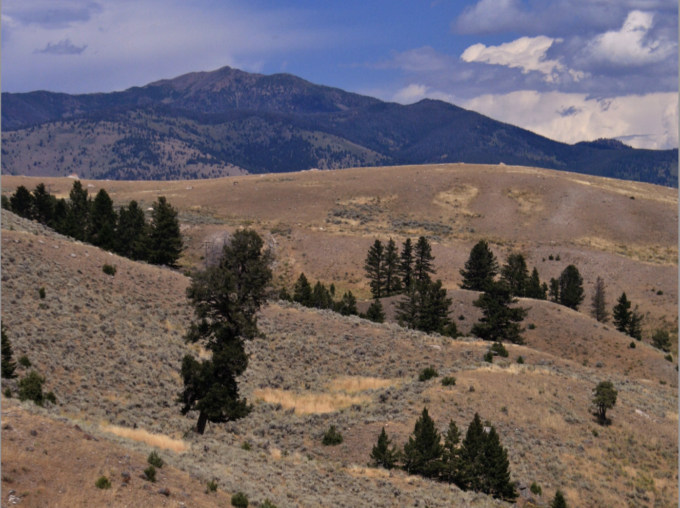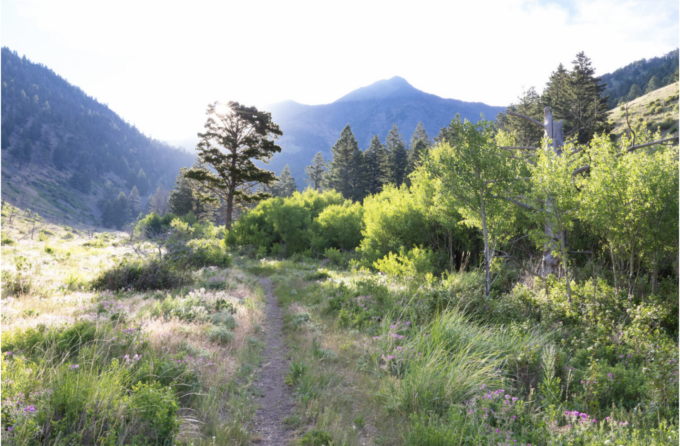We Can’t Compromise When It Comes to Preserving Wilderness

Gallatin Range, Montana.
Photo: Jeffrey St. Clair.
In the 1930s, Bob Marshall (for whom the Montana wilderness is named) started the Wilderness Society.
Marshall declared at the organization’s founding: “We do not want those whose first impulse is to compromise. We want no straddlers, for, in the past, they have surrendered too much good wilderness and primeval areas which should never have been lost.”
Marshall realized long ago that wilderness designation is the gold standard for conservation. If you want to protect an area’s ecological function, wildlife and wildness, there is no better way than formal wilderness designation.
Tragically, most of the so-called conservation groups in Montana, including the Greater Yellowstone Coalition, The Wilderness Society, and Wild Montana (formerly Montana Wilderness Association), have forgotten Marshall’s admonishment.
Today, these organizations support the Gallatin Forest Partnership, a proposal to reduce wilderness protection acreage in the Gallatin Range south of Bozeman.
Congress gave the Gallatin Range interim wilderness status in 1977 as part of Senate Bill 393. The legislation designated the 155,000-acre Hyalite-Buffalohorn-Porcupine Wilderness Study Area.
The Act requires that “the wilderness study areas designated by this Act shall, until Congress determines otherwise, be administered by the Secretary of Agriculture so as to maintain their presently existing wilderness character and potential for inclusion in the National Wilderness Preservation System.”
The word “shall” means the Forest Service has no choice but to protect the wilderness quality of the WSA. Unfortunately, the Forest Service has neglected its obligation to maintain wilderness character with the express support of the above organizations.
Approximately 155,000 acres of the Gallatin Range are within S. 393, while the Gallatin Partnership proposal only proposes 104,000 acres for wilderness designation.
Worst for wildlife and wildlands, the Partnership proposes changing WSA status for two of the Gallatin Range’s most important wildlife areas—the Buffalo Horn and Porcupine drainages to permit mechanical access by dirt bikes and mountain bikes permanently,
The Gallatin Range deserves full wilderness protection for the 155,000 acres of the S. 393 WSA and up to 100,000 acres of additional roadless lands for a 255,000-acre wilderness.
We cannot create wilderness. We can only lose it. We must acknowledge Marshall’s admonishment and keep the (fence) straddlers from compromising away one of the best wildlands in the Greater Yellowstone Ecosystem.
Please, No Diamonds for the Wilderness
Act’s 60th Anniversary

South Sister Mountain, Three Sisters Wilderness, Oregon.
Photo: Jeffrey St. Clair.
The 1964 Wilderness Act celebrates its 60th anniversary on September 3rd. Diamonds are a gift for a 60th wedding anniversary and presumably represent strength, but from a humanitarian lens diamonds have evolved to represent consumption and exploitation.
This duality resonates with the 1964 Wilderness Act’s diamond anniversary and provides an opportunity to reflect on where we are now and what the National Wilderness Preservation System—Wilderness—faces moving forward.
The Wilderness Act is exceptional. Unlike the National Environmental Policy Act, which requires the government to understand the possible environmental impacts of its proposed actions, unlike the Endangered Species Act, which protects only those species close to disappearing entirely, the Wilderness Act proactively protects ecosystems by minimizing human interference. Ecosystems and organisms within Wilderness simply exist on their own evolutionary terms, sculpted by climate, weather, and wildlife.
The Wilderness Act is our promise to restrain ourselves from consuming Wilderness in a way that degrades its future wildness. We experience Wilderness on its terms—hiking, camping, canoeing, horseback riding, hunting, and fishing. The Wilderness Act prohibits us from developing, mechanizing, degrading, or manipulating Wilderness, even with well-intentioned ideas.
Wilderness is rare. Although Wilderness encompasses 150 distinct ecosystem types nationwide, Wilderness comprises under three percent of the contiguous United States, or about five percent including Alaska. Yet Wilderness tempts special-interest groups. Surrendering to that temptation—creating exceptions for prohibited activities, the diamonds we exploit in Wilderness—will undo the Wilderness Act. The turning point is already here.
One group teeters on the precipice of attaining a nationwide exception. The EXPLORE Act would permit rock climbers to drill metal into Wilderness rock faces and leave these “fixed anchors” as permanent human footprints. One can hike without handrails, and one can climb without fixed anchors, but occasionally one must avoid a route that is otherwise too dangerous. But some climbers want their diamond! The House passed the EXPLORE Act and the Senate is considering it.
Groups are lining up behind the climbers. Utah’s Senator Lee has introduced a bill that would amend the Wilderness Act to allow bicycles—mechanized transport—in Wilderness. Exceptions are a cancer that will spread if ignored. Hand gliders are mechanized like bicycles, why not them? Electric bicycles are quiet bicycles. Electric bicycles have motors, so then why not motorized bikes, too?
Some argue that recreationists are the best wilderness advocates. But if a climber only cares about Wilderness so long as she can use fixed anchors, or a biker only cares about Wilderness insofar as he can bike there, do these folks really care about Wilderness? Or are they more enamored by the sparkly allure of a wild place to recreate with their toys?
Recreationists are hardly the only exception-seekers. Some scientists argue for installations—which the Wilderness Act prohibits—to mine data. Installations are stationary or include tracking collars that researchers and agencies shackle onto wild animals after chasing them down with helicopters. Tracking collars disorient, chafe, and sometimes even kill animals, as one researcher discovered when he found a black bear that suffocated himself trying to remove his collar. State fish and game agencies want to tinker with animal populations for hunting or fishing. These exceptions, sought in alleged pursuit of science or conservation, degrade the lives of individual animals, ignore the role of unmanipulated control groups in scientific experiments, and undermine the Wilderness Act’s mandate for untrammeled communities.
Without restraint, Wilderness dies. Half of the approximately 40 wilderness-related bills introduced to the current Congress create special-interest exceptions in proposed Wildernesses or amend the Wilderness Act. These exceptions allow motorized use, mechanized use, installations, and wildlife manipulation. Alternatively, these bills draw absurdly gerrymandered Wilderness boundaries so although a trail physically cuts through Wilderness, the trail itself is technically not Wilderness, and bikes can ride on through this loophole.
When asked why a Wilderness bill allows exceptions, which normalize Wilderness-degrading activities, Congressional offices point to stakeholders. Stakeholders want to exploit Wilderness for their diamonds, and some conservation organizations—including nationally recognizable names as well as local groups—want the nominal win of a “Wilderness” designation. Perhaps these organizations fail to consider the cost to creatures and their last truly wild sanctuaries. Worse yet, perhaps these organizations understand this market and intentionally traffic in diamonds.
We strengthen laws, follow them, or undo them. Currently, special-interest groups, abetted by Congress and some conservation organizations, are slowly undoing the Wilderness Act. This undoing leads to a future where “Wilderness” becomes an arbitrary title, bestowed without a critical look at ourselves and our ambitions.
Unlike those whose support is conditioned on exceptions, the best Wilderness advocates understand that Wilderness is where we exercise restraint—where nature evolves without intentional human interference, where humans visit without mechanization, and where we refrain from harassing wildlife and degrading their habitat. Wilderness without special-interest exceptions should be our promise to Wilderness for the next 60 years.
Collaborators on the Ropes as Wilderness
Advocates Fight Back

Emigrant Peak Trail in the Custer-Gallatin National Forest. Photo by Jacob Frank, National Park Service.
Somewhere, the industry lobbyists who successfully introduced “collaboration” to the arena of conservation policies and politics are toasting their success at splitting the conservation community. The proof is playing out right now over the collaborators’ Gallatin Conservation and Recreation Act — which is meeting significant opposition from long-time wilderness advocates.
This is nothing Montanans haven’t seen before in a number of collaborator bills, including Jon Tester’s failed Forest Jobs and Recreation Act. Likewise, his Blackfoot-Clearwater Stewardship Act is resting peacefully in the Senate since Montana’s Sen. Steve Daines, who now heads the National Republican Senatorial Committee, and will never give Tester a legislative win in an election year.
Yet, despite the utter failure of those oh-so-highly lauded collaborator bills, the Greater Yellowstone Coalition, the Montana Wilderness Association (now doing business as Wild Montana), and The Wilderness Society are pushing their attempt to chop up and dole out the remaining wilderness quality lands and Wilderness Study Areas located between Yellowstone National Park and Bozeman-Livingston.
Like the former collaborator measures, this is another “slice up the pie” act that takes wilderness quality lands and deals them out to special interests — in this case, primarily the mountainbikers, snowmobilers, and other recreationists who are legally prohibited from taking their mechanized toys into the Wilderness Study Areas, which are mandated by law to be managed as wilderness until Congress decides otherwise.
In their own words, the collaborators contend it’s “Act now or lose it all” — which is nothing more than fear-mongering by these big-dollar groups who have been milking the collaborator-friendly foundations for millions of dollars for decades.
Given the fact that Wilderness Study Areas are already protected by law, there’s no particular Sword of Damocles hanging over their heads, nor any deadline on Congressional action, nor any chance of development pressures intruding into these wilderness-quality lands.
Not only are they lying about “losing it all,” they’re equally lying about “permanent protection.” Perhaps it’s merely a sign of their incredible legislative naivete, but there is no such thing as “permanent” in law. In fact, laws are meant to be changed or they would still be burning witches at the stake, women couldn’t vote, and slaves would be in chains. If and when Congress decides to, they can amend the Wilderness Act, change designations and allowable uses, or even repeal it completely.
Moreover, their “act” hasn’t even been introduced yet in the rapidly-closing session of Congress and it’s clear they’re blowing a lot of smoke at Montanans. And guess what? True wilderness advocates are fighting back against their attempt to chop up the wildlife habitat of these incredible wilderness quality lands.
Some 40 former staffers for the Greater Yellowstone Coalition as well as a former Superintendent of Yellowstone National Park penned a strong rebuttal to the collaborators in a column titled “Let’s Not Squander Our One Opportunity To Protect A Nationally-Significant Wild Mountain Range.” Likewise, a group of prominent long-time conservation advocates and former board members of the collaborator groups put their opposition to the plan in their “Park County Leaders and Citizens Call for Protection of Wilderness Landscape” column.
While the collaborators fear-monger, the lesson, as one long-time conservationist put it, is to “advocate, not capitulate.” The Greater Yellowstone Coalition, Wild Montana and The Wilderness Society have obviously lost their way from years of wandering in the fruitless weeds of collaborative capitulation. That they’re now facing significant opposition from former staffers, board members, and long-time conservation advocates is good news for wilderness — and a wake up call to the big money collaborator groups and their plan to dole out our remaining wilderness quality lands.
No comments:
Post a Comment